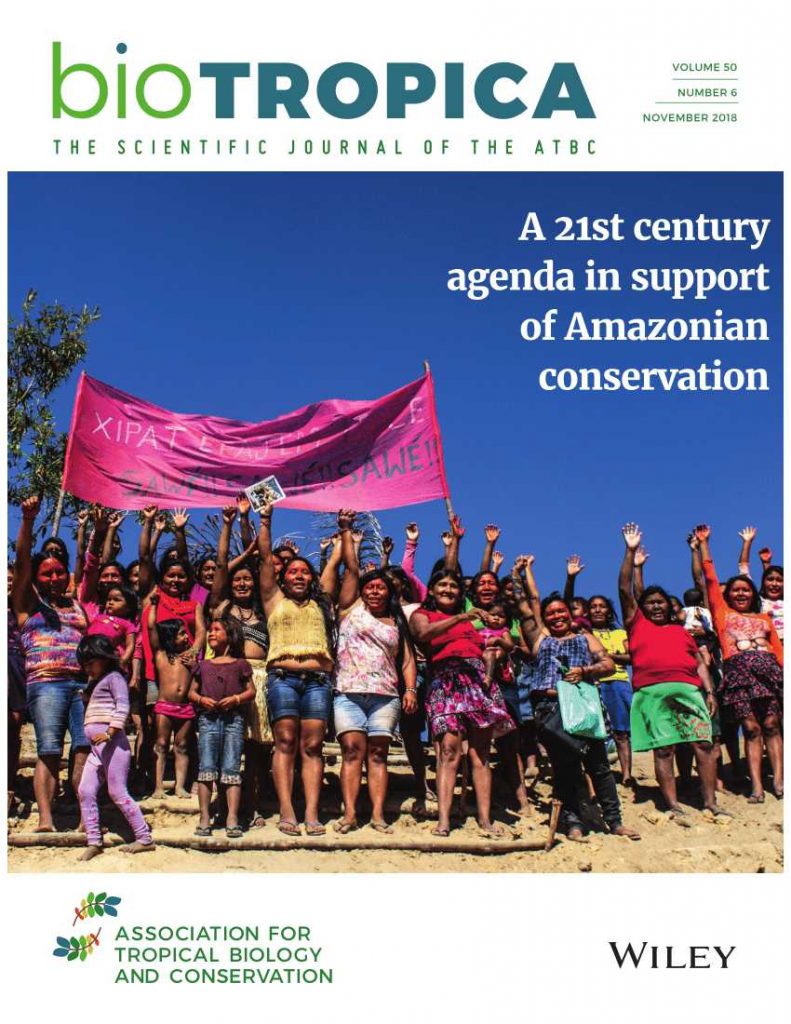 Associate Professor Dr. Cynthia Simmons and a team of international scholars – including UF Geography’s Dr. Robert Walker, Mike Waylen, and Aghane Antunes – present a strategy for achieving sustainable development in Amazonia, given global climate change and the massive infrastructure program planned for the region, in their latest paper Science in support of Amazonian conservation in the 21st century: the case of Brazil published in Biotropica, the journal of the Association of Tropical Biology and Conservation. The paper is featured on the front cover of the journal with a photo of Munduruku Women taken at gathering in July 2018 at Patawazal community in the Tapajos river valley, Para State, Brazil, taken by UF Geography doctoral student Ms. Maira Irigaray. On the banner is a greeting to participants “SAWE´! SAWE´! SAWE´!” a Munduruku battle cry signifying “We Are United, And Determined!” “The aim of the gathering was to empower and unite women and men of the tribe to defend their lands, life and culture, which today are in greater peril as Brazil’s President-elect, Jair Bolsonaro, vows to fast-track the large-scale mining and infrastructure plans they have been fighting years to stop,” said Dr. Simmons.
Associate Professor Dr. Cynthia Simmons and a team of international scholars – including UF Geography’s Dr. Robert Walker, Mike Waylen, and Aghane Antunes – present a strategy for achieving sustainable development in Amazonia, given global climate change and the massive infrastructure program planned for the region, in their latest paper Science in support of Amazonian conservation in the 21st century: the case of Brazil published in Biotropica, the journal of the Association of Tropical Biology and Conservation. The paper is featured on the front cover of the journal with a photo of Munduruku Women taken at gathering in July 2018 at Patawazal community in the Tapajos river valley, Para State, Brazil, taken by UF Geography doctoral student Ms. Maira Irigaray. On the banner is a greeting to participants “SAWE´! SAWE´! SAWE´!” a Munduruku battle cry signifying “We Are United, And Determined!” “The aim of the gathering was to empower and unite women and men of the tribe to defend their lands, life and culture, which today are in greater peril as Brazil’s President-elect, Jair Bolsonaro, vows to fast-track the large-scale mining and infrastructure plans they have been fighting years to stop,” said Dr. Simmons.
The fate of Amazonia is of great concern given its value as a global resource and the extent of its degradation to date. With nearly 20 percent of a pristine forest gone up in smoke, what happens in the 21st century will determine the fate of this last remaining tropical wilderness. The prognosis is not good, given the Initiative for the Integration of the Regional Infrastructure of South America (IIRSA), the cross-continental program of infrastructure development being undertaken by the South American nations. Recent declines in rates of deforestation have raised some hope that the Amazonian nations will be able to ensure the long-run integrity of the region’s ecosystems. The new infrastructure plans could reverse these promising trends. Land clearance for agricultural development may soon be overshadowed by forest die-back associated with global climate change. While infrastructure development will likely bring economic opportunity to the residents of Amazonia, the growth it stimulates will surely generate substantial environmental impacts and strenuous efforts will be required to conserve it for future generations.
The paper sheds light on the massive scale and integrated blueprint design of IIRSA’s transcontinental plan, which synchronizes municipal, state, and national level road and rail projects, with national hydro-electric dam projects that serve the dual purposes to generate energy required for electricity intensive industrialization and make navigable the main tributaries of the Amazon through locks and reservoirs coupled with rock demolition, dredging, and channelization. It clearly illustrates the looming threat from infrastructure plans with a focus on the Tapajos Valley, Para State, where projects will dissect the Munuduruku homelands and transform the entire basin to make way for the Mississippi of South America, Brazil’s ultimate goal to spur the economy. “Readers will be surprised by the magnitude of this integrated plan, and worried when they contemplate the potential cumulative and synergistic impacts that will surely have dire consequences for the environment and the region’s populations,” explained Dr. Simmons.
The paper articulates an approach to conservation based on decades of transdisciplinary research and collaboration among the team of scientists that envisions organizing Amazonia’s protected areas into a basin-scale System of Refugia (SR), capable of maintaining biodiversity and ecosystem services in the face of climate change. It also presents a coordinated program of interdisciplinary research capable of simulating Amazonia’s coupled natural and human systems and assessing the social and environmental impacts from IIRSA. Thus it provides essential information for planners and policy makers to select more sustainable alternatives, and it could serve as an early warning system for communities and environments at risk.
For more information, contact Dr. Cynthia Simmons. The full article is available at Biotropica.